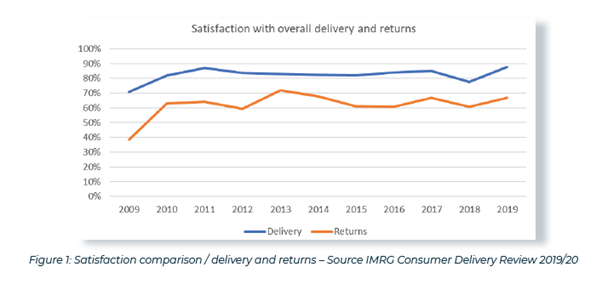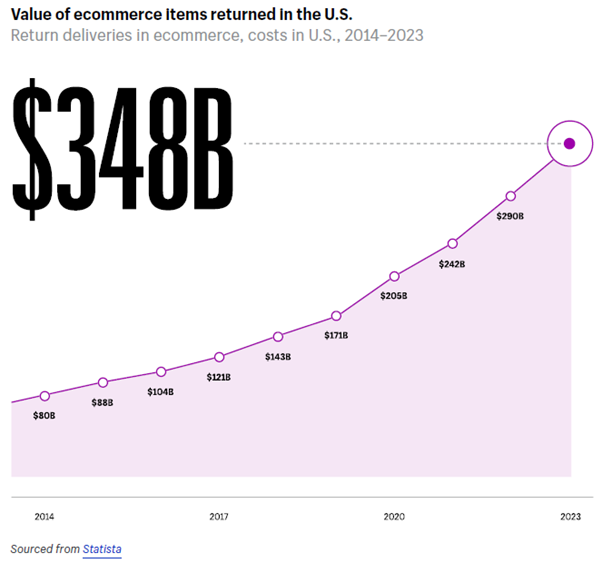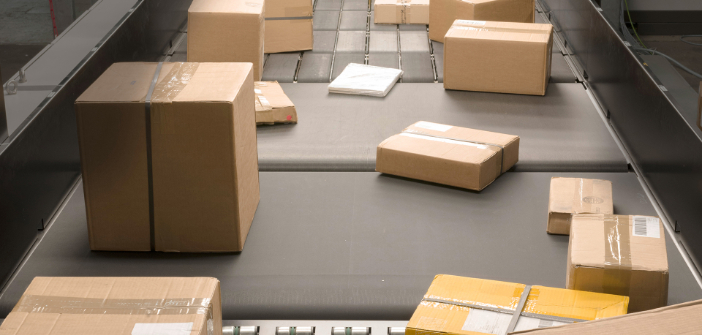A report from e-commerce platform provider Shopify recently put the total cost of worldwide returns at over US$1tn in 2020. The dollar value doesn’t tell the whole story, but it gives a sense of the scale of the issue for retailers: they know it’s a massive challenge to the bottom line but at the same time they are aware that they may lose a customer forever if they make the returns process too painful.
Returns are a high-cost, high-priority issue for retailers, but their systems to
deal with returns have historically been overlooked. Metapack data shows that customer satisfaction with returns in the last decade is pretty consistently around 20% below the same metric for delivery, which has traditionally had more resources and focus devoted to it. With legacy systems and processes, and increasing recognition that returns are an urgent and solvable problem with immediate bottom-line improvements to be gained, it’s hardly surprising that many tech companies have stepped in to fill the breach.

Become a solutions provider
The question is, why are posts and carriers relatively passive about this? There is a mindset that returns are a retailer challenge to solve, rather than a carrier one, and to an extent that’s true. But when almost all of your customer base has the same solvable problem, and you have the scale and existing relationships with them that would enable you to easily sell in solutions, choosing not to engage seems like a missed opportunity. The danger is that by allowing emergent tech companies to fill that value niche, postal carriers miss the broader opportunity to build deeper partnerships with their customer base and make it easier and better for customers to stay than to go elsewhere.
Australia Post (AP) has taken a different approach, having been convinced of the value of being on the front foot and taking an active role in returns. The organization is using Doddle’s white-label technology platform to offer seamless digital returns to its merchant customers and the end consumer. This platform has enabled AP’s merchants to turn the returns challenge into a slick experience and a data opportunity, while ensuring that AP remains more than just a transport utility in the returns ecosystem. Instead, it’s a solution provider that can genuinely claim to have made an impact on the bottom line.

Add more value
The ability to open up new revenue streams and find ways to add more value than simply moving parcels back and forth is going to be crucial if traditional posts and carriers are to survive and thrive in the next few years. The point isn’t that their core business needs to change. Amazon still sells a lot of books and other products, but Jeff Bezos and Amazon didn’t get to where they are by seeing logistics as a ‘carrier problem’. They saw their merchant user base struggling to warehouse products and fulfill orders, so they offered them a service to solve that problem. That made those merchants both more loyal and more profitable.
Adding value with extra services also gives carriers insulation against price warfare, as it elevates them above the level of a commodity – where undifferentiated products can only compete on price. Escaping that perception is essential for long-term survival, and providing meaningful solutions that help address a big bottom-line concern for retailers will go a long way toward differentiating posts and carriers in their markets.
This article was originally published in the April issue of Parcel and Postal Technology International.


